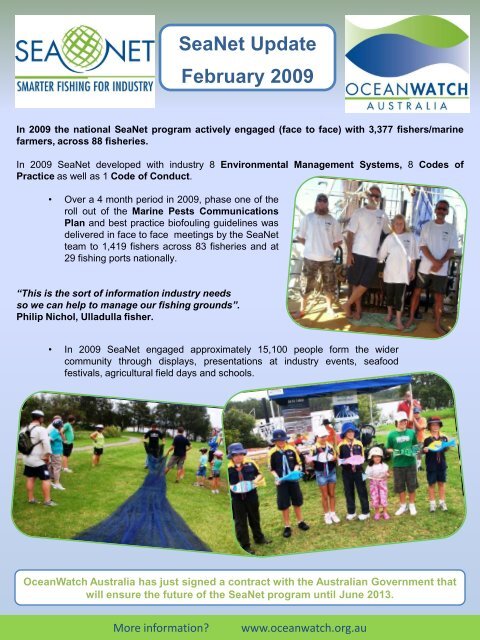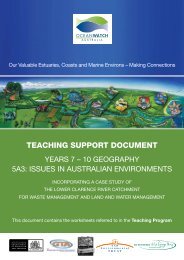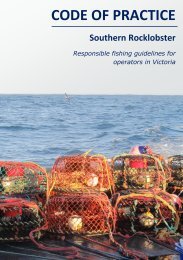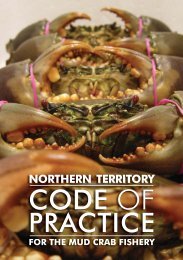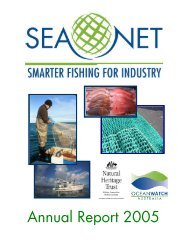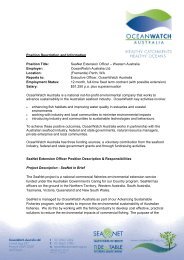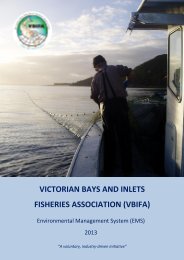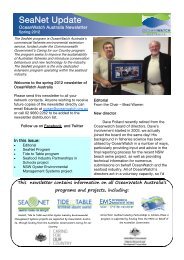SeaNet News February 09 - OceanWatch Australia
SeaNet News February 09 - OceanWatch Australia
SeaNet News February 09 - OceanWatch Australia
Create successful ePaper yourself
Turn your PDF publications into a flip-book with our unique Google optimized e-Paper software.
<strong>SeaNet</strong> Update<strong>February</strong> 20<strong>09</strong>In 20<strong>09</strong> the national <strong>SeaNet</strong> program actively engaged (face to face) with 3,377 fishers/marinefarmers, across 88 fisheries.In 20<strong>09</strong> <strong>SeaNet</strong> developed with industry 8 Environmental Management Systems, 8 Codes ofPractice as well as 1 Code of Conduct.• Over a 4 month period in 20<strong>09</strong>, phase one of theroll out of the Marine Pests CommunicationsPlan and best practice biofouling guidelines wasdelivered in face to face meetings by the <strong>SeaNet</strong>team to 1,419 fishers across 83 fisheries and at29 fishing ports nationally.“This is the sort of information industry needsso we can help to manage our fishing grounds”.Philip Nichol, Ulladulla fisher.• In 20<strong>09</strong> <strong>SeaNet</strong> engaged approximately 15,100 people form the widercommunity through displays, presentations at industry events, seafoodfestivals, agricultural field days and schools.<strong>OceanWatch</strong> <strong>Australia</strong> has just signed a contract with the <strong>Australia</strong>n Government thatwill ensure the future of the <strong>SeaNet</strong> program until June 2013.More information?www.oceanwatch.org.au
TasmaniaFiona Ewing<strong>SeaNet</strong> in Tasmania is championing an old idea, but a goody! For many years,fishermen have been visiting schools on an ad hoc basis. At the root of this is adesire to share their knowledge of marine and aquatic life and to inspire youth toperhaps take up a career in the industry. In Tasmania, <strong>SeaNet</strong> is piloting a “SeafoodIndustry Partnerships in Schools” program which is a collaborative educationalproject between the Seafood industry and Schools. This is not at all meant to replaceexisting arrangements between industry members and schools, but to inspire newpartnerships and provide resources to these as well as existing initiatives.There will be two streams to the program; “Adopt a Fishing Boat”, and “Adopt a Marine Farm”. Duringthe last term of last year, we conducted our first trial partnership between professional fisherman, BryanDenny and class four of the Lauderdale Primary School. The class loved it and as Bryan said „you cansee that the kids gained a lot of knowledge from it‟. More schools, fishermen and marine farms arealready lined up to participate this year and it is hoped that this concept can be extended nationwide inthe not too distant future.Coastal cleanups are happening in the D‟EntrecasteauxChannel and Huon River areas. I am working closelywith the Tasmanian Seafood Industry Council on aCaring for our Country Community Coastcare Grant fora coastal cleanup of Channel and Huon Coastal waters.The response to this seafood industry initiative hasbeen positive, with community environment groups,recreational boating clubs, local landholders, schoolsand oyster and salmon farmers being actively involved.The excellent relationships created during this projectwill ensure that these cleanups will continue beyond theend of project date.Rollout of the National System for the Prevention and Management of Marine Pest Incursions hastwo years to go and I will continue talking to fishers about this important issue. Tasmanian fishers arevery aware of the dangers of marine pests, so the reception has been really good. I have discussedsightings of possible marine pests with fishers – they turned out to be a native, but similar species. Ihave had a zillion comments about „seals‟ being the „biggest‟ marine pest.Dinghy fishers fishing in remote locations have had concerns about access to fresh water whentravelling between boat ramps. Many remote boat ramps in Tasmania don‟t have taps/water tanks orany running freshwater, which means that they can‟t clean their boats properly. The <strong>SeaNet</strong> Officesought advice from the DPIPWE marine pest officer, who indicated that special care should be takenwhen travelling from ports of a high risk (i.e. international shipping) such as Triabunna, Devonport,Launceston and Hobart, but in general, removing macrofouling would be adequate in remote locations(i.e. rinsing dinghy at sea with deck hose/bucket).Some fishers on west coast have reported Japanese longline buoys washing up on shore, as well asthe occasional piece of large marine debris. It is obvious by the fouling that they have been at sea formany months and the fishers were concerned that marine pests may enter our waters via this vector.Fiona Ewing – <strong>SeaNet</strong> Tasmania PH: 03 6224 2890 or 0407 135 637fiona@oceanwatch.org.auMore information?www.oceanwatch.org.au
Northern TerritoryLyn LambethLyn is working on ways to promote the professional fishing industry within thewider community, particularly with regard to sustainability and bycatch issues.Industry and government have spent many years and dollars on improving theenvironmental credentials of <strong>Australia</strong> seafood, but their achievements remainlargely unrecognised in the wider community. The <strong>SeaNet</strong>NT YouTube channelwww.youtube.com/user/<strong>SeaNet</strong>NT uses short videos to show different aspects ofthe fishing industry in Northern <strong>Australia</strong>. The channel currently has 6 uploadedvideos, including several on the development and use of Turtle Excluder Devicesin the Northern Prawn Fishery.The NT Marine Resource Management Networkwas started by Lyn to keep interested stakeholdersup to date with <strong>SeaNet</strong>, <strong>OceanWatch</strong> <strong>Australia</strong> andgeneral marine resource news. A monthlysummary email is sent around to fishers, seafoodprocessors and retailers, government and nongovernmentmarine resource managementworkers. If you would like to be added to thenetwork, please email lyn@oceanwatch.org.auLyn has also been working on a revision of thecurrent Barramundi Environmental ManagementSystem (EMS) with the assistance of an EMS teamfrom the barra industry. The group has looked atways of strengthening the EMS and increasingindustry responsibility for improving environmentalperformance. As a part of this the group has alsodeveloped a Sawfish Information Sheet to advisefishers on avoiding or minimising sawfishinteractions, and handling and release proceduresfor captured sawfish.Future NT work will include:• working with the Carpentaria Ghost netProject on their pilot project in identifying thepotential sources of ghost nets anddeveloping an identification system;• Organising a Darwin Harbour clean upweekend in partnership with Coatscare, theNT Seafood Council, the commercial fishingindustry and numerous stakeholders.• Trials of acoustic alarms in gillnet fisheries.Lyn Lambeth <strong>SeaNet</strong> NT PH: 08 8981 5194 or 0421 054 274lyn@oceanwatch.org.auMore information?www.oceanwatch.org.au
Western <strong>Australia</strong>Neil MacguffieThere‟s always something happening in the West <strong>Australia</strong>n Fishing Industry and20<strong>09</strong>/10 proved to be no exception. In October 20<strong>09</strong> I was approached by theprofessional fishermen of the South Coast Estuarine Fishery and informed of apelican problem in the fishery.The fishermen use gillnets to fish for bream, mullet, whiting and other estuarinefishes, when retrieving their nets they often release undersize and unwanted speciesback into the estuary. However pelicans are attracted to fishing activities and preyupon released fish before they have the opportunity to escape.Concerned with the rate of predationupon released fish, a member of theSouth Coast Estuarine Fisheryapproached me and we discussedfinding a solution to the problem.After a great deal of trial and errorand the development of a number ofprototypes I developed a device thatwould provide a solution to theproblem.Appropriately named the “Fishute”, the concertina stylemesh chute attaches to the side of the vessel andextends below the surface of the water. The fishermenrelease the undersize fish into the Fishute allowingthem to acclimatise, get their bearings and avoidpredation by seabirds.This project showcases the innovation and adaptionthe South Coast Estuarine Fishers are making in theimplementation of the Code of Practice forResponsible Fishing, which is a fundamental part ofthe Environmental Management System of the fishery.The Fishute project was made possible throughfunding provided by South Coast NRM and support bythe professional fishermen of the South CoastEstuarine Fishery.Neil Macguffie <strong>SeaNet</strong> WA PH: 08 94928816 or 0401 838 436neil@oceanwatch.org.auMore information?www.oceanwatch.org.au
South <strong>Australia</strong>Nathan Bicknell<strong>SeaNet</strong> SA is proud to announce a strategic partnership between<strong>OceanWatch</strong> <strong>Australia</strong> Ltd, Gulf St Vincent Prawn Boat Owners Association(GSVPBOA), Spencer Gulf Prawn Boat Owners Association (SPGPBOA),Adelaide Mount Lofty Ranges Natural Resources Management Board (AMLRNRMB) and the South <strong>Australia</strong>n Research and Development Institute(SARDI).This joint initiative will explore the concept of developing a framework for advancing trawl technologiesin SA. Survey trawls underpin the real time spatial management of South <strong>Australia</strong>‟s prawn fisheries.Broadening the scope of surveys to include technical trials has the potential to remove the significantrisks and prohibitive costs that currently stifle innovation. Fishers are also excited at the prospect of theconcept to invigorate innovation in the industry and adding significant value to the survey process.Pilot trials during the March 2010 Gulf St. Vincent survey will asses the practicalities of combining theseactivities. The pilot will test a bycatch reduction device known as the “Witches Hat BRD Enhancer”developed by J. Wakeford of the <strong>Australia</strong>n Maritime College in 2007. The device generates a wake oflow pressure water directing mobile species to the escape panelThe enhancer has been rigorously tested bythe <strong>Australia</strong>n Fisheries ManagementAuthority (AFMA) during sea trials in the2008 and 20<strong>09</strong> Northern Prawn Fisheryseasons. This BRD has proven successfulin removing up to 40% of bycatch withoutloss of target species.“The performance of this particular device iscomplemented by its comparative simplicity,which will ensure it is readily accepted byfishers” (Alan Moss, AFMA Gear technician20<strong>09</strong>).Nathan Bicknell <strong>SeaNet</strong> SA PH 08 8303 2717 or 0401 997 702nathan@oceanwatch.org.au<strong>SeaNet</strong> is supported by <strong>OceanWatch</strong> <strong>Australia</strong>, though funding from the<strong>Australia</strong>n Government‟s Caring for our Country.For more information contact the <strong>SeaNet</strong> Officer in your State or Territory, visit the <strong>OceanWatch</strong><strong>Australia</strong> website www.oceanwatch.org.au or ring <strong>OceanWatch</strong> <strong>Australia</strong> headquarters in SydneyPH 02 9660 2262More information?www.oceanwatch.org.au


